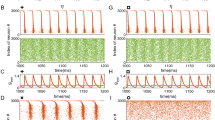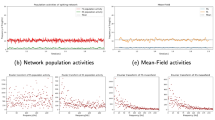Abstract
In this paper a mean field model of spatio-temporal electroencephalographic activity in the neocortex is used to computationally study the emergence of neocortical gamma oscillations as a result of neuronal response modulation. It is shown using a numerical bifurcation analysis that gamma oscillations emerge robustly in the solutions of the model and transition to beta oscillations through coordinated modulation of the responsiveness of inhibitory and excitatory neuronal populations. The spatio-temporal pattern of the propagation of these oscillations across the neocortex is illustrated by solving the equations of the model using a finite element software package. Thereby, it is shown that the gamma oscillations remain localized to the regions of neuronal modulation. Moreover, it is discussed that the inherent spatial averaging effect of commonly used electrocortical measurement techniques can significantly alter the amplitude and pattern of fast oscillations in neocortical recordings, and hence can potentially affect physiological interpretations of these recordings.












Similar content being viewed by others
References
Bojak, I., & Liley, D.T.J. (2005). Modeling the effects of anesthesia on the electroencephalogram. Physical Review E, 71, 041902. https://doi.org/10.1103/PhysRevE.71.041902.
Bojak, I., & Liley, D.T.J. (2007). Self-organized 40 Hz synchronization in a physiological theory of EEG. Neurocomputing, 70(10–12), 2085–2090. https://doi.org/10.1016/j.neucom.2006.10.087.
Bojak, I., Liley, D.T.J., Cadusch, P., Cheng, K. (2004). Electrorhythmogenesis and anaesthesia in a physiological mean field theory. Neurocomputing, 58–60, 1197–1202. https://doi.org/10.1016/j.neucom.2004.01.185.
Bojak, I., Day, H.C., Liley, D.T.J. (2013). Ketamine, propofol and the EEG: A neural field analysis of HCN1-mediated interactions. Frontiers in Computational Neuroscience 7(22). https://doi.org/10.3389/fncom.2013.00022.
Bojak, I., Stoyanov, Z.V., Liley, D. (2015). Emergence of spatially heterogeneous burst suppression in a neural field model of electrocortical activity. Frontiers in Computational Neuroscience 9(18). https://doi.org/10.3389/fnsys.2015.00018.
Buzsáki, G., & Wang, X.J. (2012). Mechanisms of gamma oscillations. Annual Review of Neuroscience, 35 (1), 203–225. https://doi.org/10.1146/annurev-neuro-062111-150444.
Buzsáki, G., & Watson, B.O. (2012). Brain rhythms and neural syntax: implications for efficient coding of cognitive content and neuropsychiatric disease. Dialogues in Clinical Neuroscience, 14(4), 345–367.
Cardin, J.A., Palmer, L.A., Contreras, D. (2008). Cellular mechanisms underlying stimulus-dependent gain modulation in primary visual cortex neurons in vivo. Neuron, 59(1), 150–160. https://doi.org/10.1016/j.neuron.2008.05.002.
Cardin, J.A., Carlén, M., Meletis, K., Knoblich, U., Zhang, F., Deisseroth, K., Tsai, L., Moore, C.I. (2009). Driving fast-spiking cells induces gamma rhythm and controls sensory responses. Nature, 459, 663–667. https://doi.org/10.1038/nature08002.
Dafilis, M.P., Liley, D.T.J., Cadusch, P.J. (2001). Robust chaos in a model of the electroencephalogram: Implications for brain dynamics. Chaos, 11(3), 474–478. https://doi.org/10.1063/1.1394193.
Dafilis, M.P., Frascoli, F., Cadusch, P.J., Liley, D.T.J. (2013). Four dimensional chaos and intermittency in a mesoscopic model of the electroencephalogram. Chaos, 23(2), 023111. https://doi.org/10.1063/1.4804176.
Dafilis, M.P., Frascoli, F., Cadusch, P.J., Liley, D.T.J. (2015). Extensive four-dimensional chaos in a mesoscopic model of the electroencephalogram. The Journal of Mathematical Neuroscience 5(1). https://doi.org/10.1186/s13408-015-0028-3.
Dehghani, N., Peyrache, A., Telenczuk, B., Quyen, M.L.V., Halgren, E., Cash, S.S., Hatsopoulos, N.G., Destexhe, A. (2016). Dynamic balance of excitation and inhibition in human and monkey neocortex. Scientific Reports, 6, 23176. https://doi.org/10.1038/srep23176.
Dhooge, A., Govaerts, W., Kuznetsov, Y.A., Meijer, H.G.E., Sautois, B. (2008). New features of the software MatCont for bifurcation analysis of dynamical systems. Mathematical and Computer Modelling of Dynamical Systems, 14(2), 147–175. https://doi.org/10.1080/13873950701742754.
Disney, A.A., Aoki, C., Hawken, M.J. (2007). Gain modulation by nicotine in macaque v1. Neuron, 56 (4), 701–713. https://doi.org/10.1016/j.neuron.2007.09.034.
van Ede, F., Quinn, A.J., Woolrich, M.W., Nobre, A.C. (2018). Neural oscillations: Sustained rhythms or transient burst-events? Trends in Neurosciences, 41(7), 415–417. https://doi.org/10.1016/j.tins.2018.04.004.
Fino, E., & Yuste, R. (2011). Dense inhibitory connectivity in neocortex. Neuron, 69(6), 1188–1203. https://doi.org/10.1016/j.neuron.2011.02.025.
Foster, B.L., Bojak, I., Liley, D.T.J. (2008). Population based models of cortical drug response: insights from anaesthesia. Cognitive Neurodynamics, 2(4), 283–296. https://doi.org/10.1007/s11571-008-9063-z.
Frascoli, F., Dafilis, M.P., van Veen, L., Bojak, I., Liley, D.T.J. (2008). Dynamical complexity in a mean-field model of human EEG. Proceedings of SPIE, 7270, 72700V–72700V–10. https://doi.org/10.1117/12.813966.
Frascoli, F., van Veen, L., Bojak, I., Liley, D.T.J. (2011). Metabifurcation analysis of a mean field model of the cortex. Physica D: Nonlinear Phenomena, 240(11), 949–962. https://doi.org/10.1016/j.physd.2011.02.002.
Green, K.R., & van Veen, L. (2014). Open-source tools for dynamical analysis of Liley’s mean-field cortex model. Journal of Computational Science, 5(3), 507–516. https://doi.org/10.1016/j.jocs.2013.06.001.
Haider, B., & McCormick, D.A. (2009). Rapid neocortical dynamics: Cellular and network mechanisms. Neuron, 62(2), 171–189. https://doi.org/10.1016/j.neuron.2009.04.008.
Herrero, J.L., Gieselmann, M.A., Thiele, A. (2017). Muscarinic and nicotinic contribution to contrast sensitivity of macaque area V1 neurons. Frontiers in Neural Circuits, 11, 106. https://doi.org/10.3389/fncir.2017.00106.
Jia, X., & Kohn, A. (2011). Gamma rhythms in the brain. PLOS Biology, 9(4), e1001045. https://doi.org/10.1371/journal.pbio.1001045.
Jones, SR. (2016). When brain rhythms aren’t ’rhythmic’: implication for their mechanisms and meaning. Current Opinion in Neurobiology, 40, 72–80. https://doi.org/10.1016/j.conb.2016.06.010, systems neuroscience.
Knoblich, U., Siegle, J., Pritchett, D., Moore, C.I. (2010). What do we gain from gamma? Local dynamic gain modulation drives enhanced efficacy and efficiency of signal transmission. Frontiers in Human Neuroscience, 4, 185. https://doi.org/10.3389/fnhum.2010.00185.
Kopell, N., Ermentrout, G.B., Whittington, M.A., Traub, R.D. (2000). Gamma rhythms and beta rhythms have different synchronization properties. Proceedings of the National Academy of Sciences, 97(4), 1867–1872. https://doi.org/10.1073/pnas.97.4.1867.
Kramer, M.A., Kirsch, H.E., Szeri, A.J. (2005). Pathological pattern formation and cortical propagation of epileptic seizures. Journal of the Royal Society Interface, 2, 113–127. https://doi.org/10.1098/rsif.2005.0028.
Kramer, M.A., Szeri, A.J., Sleigh, J.W., Kirsch, H.E. (2006). Mechanisms of seizure propagation in a cortical model. Journal of Computational Neuroscience, 22(1), 63–80. https://doi.org/10.1007/s10827-006-9508-5.
Kramer, M.A., Truccolo, W., Eden, U.T., Lepage, K.Q., Hochberg, L.R., Eskandar, E.N., Madsen, J.R., Lee, J.W., Maheshwari, A., Halgren, E., Chu, C.J., Cash, S.S. (2012). Human seizures self-terminate across spatial scales via a critical transition. Proceedings of the National Academy of Sciences, 109(51), 21116–21121. https://doi.org/10.1073/pnas.1210047110.
Lee, C.K., & Huguenard, J.R. (2011). Martinotti cells: Community organizers. Neuron, 69(6), 1042–1045. https://doi.org/10.1016/j.neuron.2011.03.003.
Lee, S., & Jones, S.R. (2013). Distinguishing mechanisms of gamma frequency oscillations in human current source signals using a computational model of a laminar neocortical network. Frontiers in Human Neuroscience, 7, 869. https://doi.org/10.3389/fnhum.2013.00869.
Liley, D.T.J., & Bojak, I. (2005). Understanding the transition to seizure by modeling the epileptiform activity of general anesthetic agents. Journal of Clinical Neurophysiology, 22(5), 300–313. https://doi.org/10.1097/01.wnp.0000184049.57793.0b.
Liley, D.T.J., & Walsh, M. (2013). The mesoscopic modelling of burst suppression during anaesthesia. Frontiers in Computational Neuroscience 7(46). https://doi.org/10.3389/fncom.2013.00046.
Liley, D.T.J., Cadusch, P.J., Dafilis, M.P. (2002). A spatially continuous mean field theory of electrocortical dynamics. Network: Computation in Neural Systems, 13, 67–113. https://doi.org/10.1080/net.13.1.67.113.
Lopour, B.A., Tasoglu, S., Kirsch, H.E., Sleigh, J.W., Szeri, A.J. (2011). A continuous mapping of sleep states through association of EEG with a mesoscale cortical model. Journal of Computational Neuroscience, 30(2), 471–487. https://doi.org/10.1007/s10827-010-0272-1.
Martinet, L.E., Fiddyment, G., Madsen, J.R., Eskandar, E.N., Truccolo, W., Eden, U.T., Cash, S.S., Kramer, M.A. (2017). Human seizures couple across spatial scales through travelling wave dynamics. Nature Communications, 8, 14896. https://doi.org/10.1038/ncomms14896.
McCormick, D.A. (1992). Neurotransmitter actions in the thalamus and cerebral cortex and their role in neuromodulation of thalamocortical activity. Progress in Neurobiology, 39(4), 337–388. https://doi.org/10.1016/0301-0082(92)90012-4.
McCormick, D.A., Wang, Z., Huguenard, J. (1993). Neurotransmitter control of neocortical neuronal activity and excitability. Cerebral Cortex, 3(5), 387–398. https://doi.org/10.1093/cercor/3.5.387.
Ni, J., Wunderle, T., Lewis, C.M., Desimone, R., Diester, I., Fries, P. (2016). Gamma-rhythmic gain modulation. Neuron, 92(1), 240–251. https://doi.org/10.1016/j.neuron.2016.09.003.
Ray, S., & Maunsell, J.H.R. (2015). Do gamma oscillations play a role in cerebral cortex? Trends in Cognitive Sciences, 19(2), 78–85. https://doi.org/10.1016/j.tics.2014.12.002.
Shirani, F., Haddad, W.M., de la Llave, R. (2017). On the global dynamics of an electroencephalographic mean field model of the neocortex. SIAM Journal on Applied Dynamical Systems, 16(4), 1969–2029. https://doi.org/10.1137/16M1098577.
Steyn-Ross, D.A., Steyn-Ross, M.L., Sleigh, J.W., Wilson, M.T., Gillies, I.P., Wright, J.J. (2005). The sleep cycle modelled as a cortical phase transition. Journal of Biological Physics, 31(3), 547–569. https://doi.org/10.1007/s10867-005-1285-2.
Steyn-Ross, M.L., Steyn-Ross, D.A., Sleigh, J.W. (2004). Modelling general anaesthesia as a first-order phase transition in the cortex. Progress in Biophysics and Molecular Biology, 85(2–3), 369–385. https://doi.org/10.1016/j.pbiomolbio.2004.02.001.
Thurley, K., Senn, W., Lüscher, H R. (2008). Dopamine increases the gain of the input-output response of rat prefrontal pyramidal neurons. Journal of Neurophysiology, 99(6), 2985–2997. https://doi.org/10.1152/jn.01098.2007.
Traub, R.D., Whittington, A.M., Buhl, E.H., Jefferys, J.G.R., Faulkner, H.J. (1999). On the mechanism of the \({\gamma } \rightarrow \upbeta \) frequency shift in neuronal oscillations induced in rat hippocampal slices by tetanic stimulation. Journal of Neuroscience, 19 (3), 1088–1105. https://doi.org/10.1523/JNEUROSCI.19-03-01088.1999.
van Veen, L., & Green, K.R. (2014). Periodic solutions to a mean-field model for electrocortical activity. The European Physical Journal Special Topics, 223(13), 2979–2988. https://doi.org/10.1140/epjst/e2014-02311-y.
van Veen, L., & Liley, D.T.J. (2006). Chaos via Shilnikov’s saddle-node bifurcation in a theory of the electroencephalogram. Physical Review Letters, 97, 208101. https://doi.org/10.1103/PhysRevLett.97.208101.
Whittington, M.A., Traub, R.D., Kopell, N., Ermentrout, B., Buhl, E.H. (2000). Inhibition-based rhythms: experimental and mathematical observations on network dynamics. International Journal of Psychophysiology, 38 (3), 315–336. https://doi.org/10.1016/S0167-8760(00)00173-2.
Wilson, M.T., Marcus, T., Sleigh, J.W., Steyn-Ross, D.A., Steyn-Ross, M.L. (2006a). General anesthetic-induced seizures can be explained by a mean-field model of cortical dynamics. Anesthesiology, 104(3), 588–593.
Wilson, M.T., Steyn-Ross, D.A., Sleigh, J.W., Steyn-Ross, M.L., Wilcocks, L.C., Gillies, I.P. (2006b). The K-complex and slow oscillation in terms of a mean-field cortical model. Journal of Computational Neuroscience, 21(3), 243–257. https://doi.org/10.1007/s10827-006-7948-6.
Author information
Authors and Affiliations
Corresponding author
Ethics declarations
Conflict of interests
The authors declare that they have no conflict of interest.
Additional information
Action Editor: Ingo Bojak
Publisher’s note
Springer Nature remains neutral with regard to jurisdictional claims in published maps and institutional affiliations.
Appendix: Bifurcation analysis results for a different set of parameter values
Appendix: Bifurcation analysis results for a different set of parameter values
To show the robustness of the results of Sections 3 and 4 against changes in parameter values, the bifurcation analysis of these sections is repeated in this appendix for a different set of parameter values as given in Table 3. These parameter values are generated by randomly perturbing the values used in Sections 3 and 4 by a magnitude of 10 to 100 percent. The codimension-one bifurcation diagrams and the frequency of the limit cycles are shown in Figs. 13 and 14. These diagrams resemble the diagrams shown in Figs. 2 and 3, respectively, and equivalently imply the emergence of gamma oscillations as a result of a Hopf bifurcation. The result of two-parameter continuation of the bifurcation points detected in Fig. 13a for neuronal sensitivity modulation is shown in Fig. 15. The bifurcation diagrams for the nominal value of Fe given in Table 3, as well as the diagram for a modulated lower value of Fe = 13 [s− 1] are shown in Fig. 16, which illustrates the coordinated transition from gamma oscillations to the initial resting state. The results are highly comparable to the results obtained in Section 4. Similarly, two-parameter analysis of excitability (μe and μi) and saliency (σe and σi) modulations leads to results very close to those obtained in Section 4, and hence are not included here.
Frequency of the limit cycles in the bifurcation diagrams shown in Fig. 13
Two-parameter continuation of the bifurcation points shown in Fig. 13a. The starting bifurcation points are indicated by dots with the same colors as they appear in Fig. 13a. The curve shown in gray is the result of the continuation of a fold bifurcation of limit cycles that is not made visible in Fig. 13a. The detected codimension-two zero-Hopf bifurcation point is indicated by ZH. The detected codimension-two generalized Hopf bifurcation point is indicated by GH
Mechanism of transient emergence of gamma oscillations through coordinated modulation of inhibitory and excitatory neuronal sensitivity. The diagrams are obtained using the parameter values described in the Appendix. The description of the modulatory actions and phase transitions in Steps 1 to 4 follows the same description as given in Fig. 8
A note on using MatCont for the numerical bifurcation analysis of this paper can be of interest for future works on this model. The MatCont versions 6.6 and 7.1 were used to perform the computations. To achieve convergence and obtain the full extent of the curves presented in the bifurcation diagrams, the continuation parameters are usually needed to be re-adjusted manually for each diagram. These re-adjustments are especially needed when continuing the curves of limit cycles and their fold bifurcations. The convergence error typically observed is ‘current step size too small’. The direction of the continuation of limit cycles may occasionally be reversed during the continuation, especially near the fold bifurcations. No general rule was observed for adjusting the continuation parameters so that these problems are resolved. However, setting the number of mesh points equal to 6 and the number of collocation points equal to 5 usually results in smoother continuation of the limit cycles. Adjustment of the initial amplitude can affect the convergence of the continuations. A value between 0.1 to 5 was typically chosen for this parameter. Finally, adjustment of the maximum step size MaxStepsize option for continuation of the limit cycles is frequently needed to resolve convergence errors or to avoid reversals in the direction of continuation. Values as large as 50000 or larger for MaxStepsize are needed in some cases.
Rights and permissions
About this article
Cite this article
Shirani, F. Transient neocortical gamma oscillations induced by neuronal response modulation. J Comput Neurosci 48, 103–122 (2020). https://doi.org/10.1007/s10827-019-00738-0
Received:
Revised:
Accepted:
Published:
Issue Date:
DOI: https://doi.org/10.1007/s10827-019-00738-0








